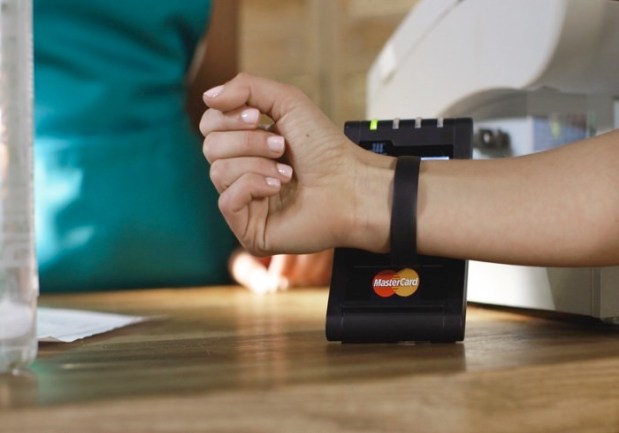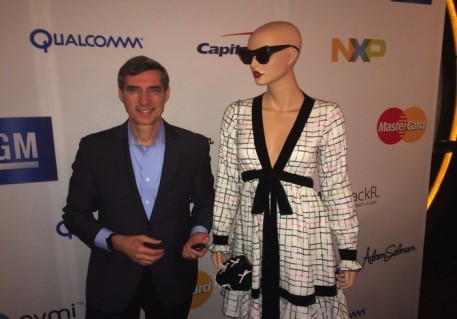Enabling Payments In An IoT World

Fifty billion points of commerce – that’s the opportunity to expand commerce to places and devices that we can’t even as yet imagine. That’s the crux of MasterCard’s vision for commerce – announced yesterday. James Anderson, Group Executive – Platforms, Emerging Payments at MasterCard, sat down with in advance of the launch MPD CEO Karen Webster for an inside look at how MasterCard’s new program is doing that – and how tokenization will help it scale.
Fifty billion points of commerce – that’s the opportunity to expand commerce to places and devices that we can’t even as yet imagine. That’s the crux of MasterCard’s vision for commerce – announced yesterday. James Anderson, Group Executive – Platforms, Emerging Payments at MasterCard, sat down with in advance of the launch MPD CEO Karen Webster for an inside look at how MasterCard’s new program is doing that – and how tokenization will help it scale.
Imagine that a consumer could turn any accessory into a commerce device – their favorite piece of jewelry, handbag, sunglasses or the key fob she used to take her unlock her car. That marriage between the Internet of Things (IoT) and payments is what MasterCard believes is the not-so-distant future of commerce – and vision they announced yesterday they’ll are making a today.
MasterCard announced yesterday its platform for bringing payments to a wide array of consumer products, from apparel to automotive, wearables and even categories that have yet to be imagined that represent the more than 50 billion devices that will be connected to the Internet by 2020.
Yesterday, Ed McLaughlin, Chief Emerging Payments Officer at MasterCard, debuted the first payment prototypes from its program launch partners, noting that the proliferation of Internet-connected devices will be part of a reengineering of commerce as we know it.
“We see the integration of payment as foundational for a whole set of new experiences,” McLaughlin said during his presentation.
By utilizing IoT, which supports the hyper-connectivity of everyday items to the Internet, MasterCard’s program seeks to provide consumers with the ability to shop with the devices that are most convenient to them, while still facilitating secure transactions.
In working with companies like NXP and Qualcomm Incorporated, the technology utilized through MasterCard’s program enables secure payments on virtually any device or accessory by establishing a unique number (token) into a payment device that links the product to a consumer’s bank account. Each payment device is also equipped with a security key in order to generate EMV transactions.
Tokenization is a critical piece of the payments-enablement puzzle for MasterCard’s new program, which McLaughlin said is necessary in ensuring consumers feel as though they have control over their payment data, no matter which device they are using to make transactions happen.
“We are liberating payments to be something that a whole bunch of people can integrate into part of their own customer journey,” James Anderson, Group Executive – Platforms, Emerging Payments at MasterCard, explained in an interview with Karen Webster just days before the launch.
“Because we are leveraging tokens and the MasterCard Digital Enablement Service (MDES) infrastructure, while supporting EMV transactions and NFC, payments can now be a secure part of many different products,” Anderson added.
“The way you make payments truly safe is you make it useless if it’s used out of context; that’s what we are doing with tokenization,” McLaughlin explained.
MasterCard’s program launch includes a diverse set of partnerships, selected to not only bring an array of different perspectives on what payments mean for their businesses, but also to demonstrate the breadth of potential use cases for the technology.
While the payments-enabled devices and designs are still in the prototype phase of development, McLaughlin said that consumers can expect to see products from several marquee partners — which include celebrity designer Adam Selman, automaker General Motors, wearable technology company Nymi, smart jewelry creator Ringly, and Bluetooth locator TrackR — to go to market in 2016.
Turning everyday devices into commerce devices, which is made possible through MasterCard’s MDES platform and Digital Enablement Express (Express) program, will open the door to more cases in which businesses will be able to put a token into their device and make it a meaningful part of their customer’s journey, Anderson said.
“[MasterCard’s device partners] want to add payments to their device to make the device more valuable, but their primary business is not enabling payments, their primary business is their product, whether it be jewelry or smart bands. We wanted to keep the system and IT requirements as minimal as possible, but still consistent with a good user experience,” he remarked.
By ensuring that the actual interaction with the token is funneled back through to the issuer, say a mobile wallet or mobile banking application, the program is able to ensure that real-time notification and changes that may need to be made are mapped back to the issuing bank.
Not only does this meet consumers’ expectations, but Anderson added that it also releases the device manufacturer or designer from undue burdens surrounding the payment itself.
“This is just the first wave and we genuinely expect that there’s potentially thousands of device manufacturers out there who want to be token requestors,” Anderson said.
“We’re hoping that we are going to hear from a lot of people we haven’t thought of or use cases we haven’t had the creativity to think of. That’s what makes it exciting.”
Through its new program, MasterCard is creating a platform others will have the ability to innovate on top of at scale, enabling payments to be brought to even more devices and designs and creating the opportunity for greater commerce innovation over time.
“We talk about the devices and things people have today, but we are always making sure we are ready for the as-of-yet unimagined next device. As you think of all of the innovation, all of the connectivity we are going to see going forward, what you’re seeing today is the true foundation to allow commerce to occur safely, securely across every device a consumer has,” McLaughlin said.
To learn more about how MasterCard is working to turn any consumer gadget, accessory or wearable into a payment device, check out the video below:


